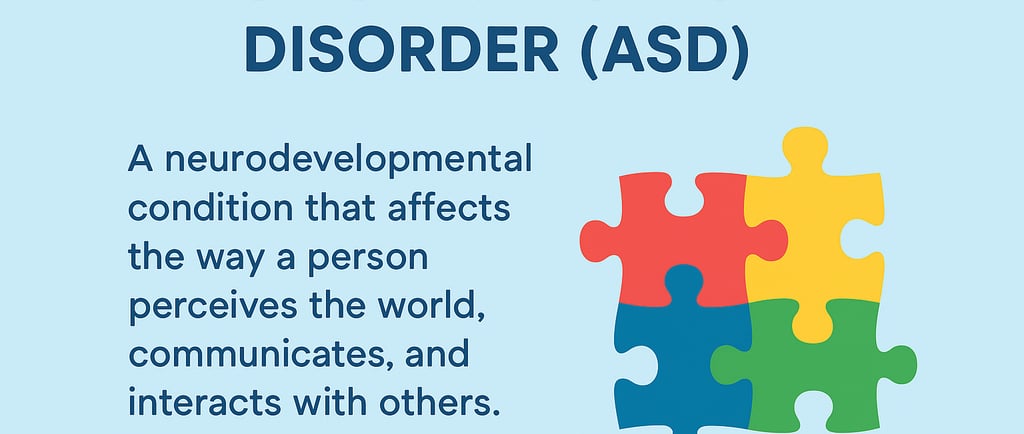Autism Spectrum Disorder (ASD): Symptoms, Diagnosis, and Treatment What is Autism Spectrum Disorder?
Autism Spectrum Disorder (ASD): Symptoms, Diagnosis, and Treatment What is Autism Spectrum Disorder?
10/1/20252 min read


Autism Spectrum Disorder (ASD): Symptoms, Diagnosis, and Treatment
What is Autism Spectrum Disorder?
Autism Spectrum Disorder (ASD) is a neurodevelopmental condition that affects how a person perceives the world, communicates, and interacts with others. It is characterized by difficulties in social interaction, communication, and the presence of repetitive behaviors or restricted interests.
The term “spectrum” is used because autism symptoms can vary widely in each individual, both in type and severity.
Types of Conditions Within the Spectrum
Previously, several conditions were considered separate diagnoses:
Classic Autism
Asperger’s Syndrome
Childhood Disintegrative Disorder
Pervasive Developmental Disorder – Not Otherwise Specified (PDD-NOS)
Today, all of these are part of Autism Spectrum Disorder.
When Do the First Symptoms Appear?
Autism in children usually becomes noticeable in the early years of life.
Some babies show signs before their first birthday.
Others seem to develop typically until 18–24 months, and then lose social or language skills.
- Early detection is essential, as timely intervention can greatly improve quality of life.
Common Symptoms of ASD
1. Communication and Social Interaction
Little or no eye contact
Not responding to their name
Speech delay or language regression
Difficulty starting or maintaining conversations
Limited facial expressions or unusual tone of voice
Trouble understanding emotions, gestures, or social cues
Preference for playing alone or self-isolation
2. Repetitive Behaviors and Patterns
Repetitive movements (rocking, hand-flapping)
Strong attachment to routines and distress over changes
Highly specific or unusual interests
Extreme sensitivity to sounds, lights, or textures
Limited pretend play or lack of imitation
Important: Autism symptoms vary from person to person. Some children have normal or above-average intelligence but face social difficulties, while others may experience significant developmental delays.
Autism Diagnosis
The diagnosis of Autism Spectrum Disorder is based on:
Observation of development and behavior
Evaluations of language, interaction, and communication
Developmental screening tests
In some cases, diagnosis may not occur until adolescence or adulthood, especially in individuals with milder symptoms.
Treatment and Management
Although there is no cure for autism, early intervention therapies can make a significant difference. Common approaches include:
Speech and language therapy
Behavioral and educational interventions
Psychological and social support
Complementary medical interventions
Treatment should always be personalized and adapted to each individual’s needs.
When to See a Doctor
Consult a pediatrician or child development specialist if your child:
Does not respond to their name
Loses previously acquired skills
Shows speech or social delays
Avoids eye contact or withdraws socially
Conclusion
Autism Spectrum Disorder (ASD) does not define a person—it is simply part of their unique way of experiencing the world. With early detection, proper therapies, and family support, many children and adults with autism can thrive, develop their abilities, and lead fulfilling lives.
Explore
Join us in the adventure of parenting.
Resources
Support
2021 © 2025. All rights reserved.
